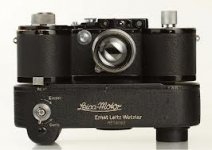Ron & furcafe
All I was trying to say is all existing M-mount lenses require a minimum distance between the rear element and the sensor for the microlenses to collect enough light from the frame edges. The physics makes it even harder as the sensor area increases. Even the current Ms use in-camera firmware to correct color shifts and vignetting with some M lenses (or am I confused or misremember?). M lenses are coded or a reason, right?
Nikon or Canon could have used their own contemporary mounts with a mechanical RF if they wanted too. Adapting their existing optics designs for mechanical focusing would be trivial. It was not impossible, just inconsistent with their business models. And most relevant to this thread, the cameras would have been thicker than the M8 or M9.
So a thicker non-M mount mechanical RF camera that could not use M lenses was possible years ago. Nobody bothered to make one.
By the way, Leica was rather brave and innovative to bring the M8 to market. The M9 series is also clearly innovative and technically challenging. I suspect live view (or whatever Leica calls it) adds a bit to the thickness of the newest Ms because the heat build up from continuous operation must be dissipated using purely mechanical means. Of course that's just speculation. Only Leica knows why the bodies are getting thicker.


